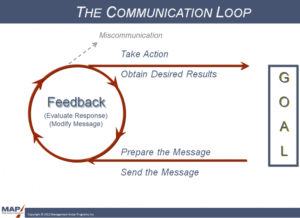Master the ‘Art’ of Communication
There’s no mystery here — regardless of whether you’re talking about business, politics, sports, the military or even personal life, the best leaders are first-rate communicators. Their values are clear and solid, and what they say promotes those values. Their teams admire them and follow their lead. Likewise, if you want your company to reach such benchmarks of achievement, you must learn to master the art of communication.
Click here to download our free effective communication checklist.
So how do you do it? Realize and accept that clear communication is always a two-way process. It’s not enough to speak clearly; you have to make sure you’re being heard and understood. To facilitate this, use the following two-way communication primer:
- Prepare how you’ll communicate — Planning ahead leads to better results. So scrutinize the topic, issue or problem at hand, answering those critical who, what, where, when and why questions on your own. Trying to address those prior to the actual communication experience will help empower you with information and give you more confidence when you deliver either in person, via email or otherwise. Also clarify the goal of the message and try to anticipate the receiver’s viewpoints and feelings.
- Deliver the message — Remember, it’s not just what you say, it’s how you say it. So first, choose the right medium for communicating the message — that’s part of the “how.” If it’s serious enough to warrant a face-to-face conversation, don’t hide behind an email and try and get the job done. Once you’ve picked the right message mode, then say/write what you think or feel with conviction, particularly if it’s truly important. Consider the balance between what’s verbal and nonverbal, keeping in mind tone, inflection, word choice, eye contact, gestures, posture, wordiness, grammar, etc. Always relate the message to your larger goals and identify the action that’s to be taken.
- Receive the message — Have recipients tell you what they’re understanding so you are SURE they’ve got it. Then, keep an open mind about what you might learn — It might not be what you thought or hoped you communicated! Ask them to relay back the key points; then confirm for them that YOU understand that they understand you.
Also build in feedback loops to get input on how the communication went, so you can learn from or improve upon it in the future. If you’re not comfortable asking the direct recipient(s) for feedback, petition a trusted advisor or objective confidant for his/her thoughts. Pay attention to how people are acting after you’ve communicated your message — this alone can quickly tip you off to how well the message was delivered, understood or accepted. If people say they are Ok with something and then act upset, back to the drawing board you go! Finally, be ready to make adjustments. Good leaders embrace the opportunity to change based on what is and isn’t working. When it comes to communication, a willingness to adapt and improve is a powerful, vital leadership trait.
What’s your most common communication blunder with direct reports?



